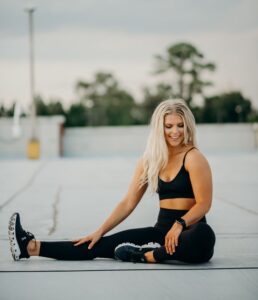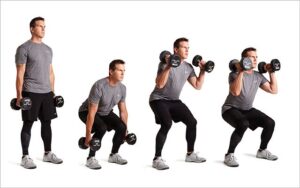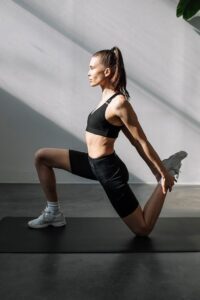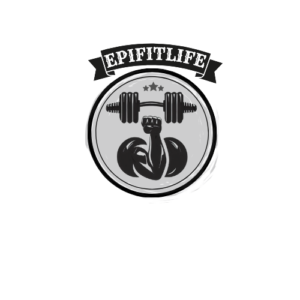TRAIN YOURSELF AT HOME WITH US
There are many effective exercises you can do at home to train yourself and improve your fitness. Whether you’re looking to build strength, increase flexibility, or improve your cardiovascular fitness, there are options for all fitness levels. Here’s a list of exercises you can do at home without the need for special equipment, exercises to create a well-rounded home workout routine.
Cardiovascular Endurance:
1. Jumping Jacks: Stand with your feet together, then jump, spreading your arms and legs. Return to the starting position and repeat.

2. High Knees:
Run in place, lifting your knees as high as possible with each step.
3. Mountain Climbers: Start in a push-up position and alternate bringing your knees to your chest in a running motion.
4. Burpees: Begin by standing, then drop into a push-up position, perform a push-up, jump your feet back to your hands, and then jump up explosively.
5. Jump Rope: If you have a skipping rope, jump rope for a great cardiovascular workout.
Strength Training:
6. Push-Ups: Place your hands shoulder-width apart, lower your body to the ground, and push back up.
7. Bodyweight Squats: Stand with your feet hip-width apart, bend your knees, and lower your body as if sitting in a chair.
8. Planks: Hold a push-up position with your arms straight or on your forearms, engaging your core muscles.
9. Tricep Dips: Sit on the edge of a sturdy chair or step, place your hands on the edge, and dip your body up and down.
10. Lunges: Step forward with one leg, bend both knees to 90-degree angles, then return to the starting position.
Flexibility and Mobility:
11. Yoga: Various yoga poses can improve flexibility and balance.
12. Static Stretches: Stretch your major muscle groups (hamstrings, quads, calves, shoulders, etc.) and hold each stretch for 20-30 seconds.
13. Pilates: Incorporate Pilates movements that emphasize core strength and flexibility.
Balance and Coordination:
14. Single-Leg Stands: Stand on one leg and maintain your balance for 30 seconds, then switch to the other leg.
15. Heel-to-Toe Walk: Walk in a straight line placing the heel of one foot directly in front of the toes of the other.
16. Balance Exercises: Try standing on one leg with your eyes closed, or use a balance board for added challenge.

Train Yourself For Core Strength:
17. Russian Twists: Sit on the floor, lean back slightly, and twist your torso to touch the floor on each side.
18. Leg Raises: Lie on your back, lift your legs, and lower them without touching the ground to train youself.
19. Bicycle Crunches: Lie on your back and bring one knee toward your chest while twisting your torso to touch the opposite elbow.
20. Superman: Lie on your stomach, lift your arms and legs off the ground, and hold for a few seconds.
Full Body Workouts:
21. Bodyweight Circuits: Create a circuit that combines different exercises (e.g., push-ups, squats, and planks) and perform them in succession.
22. Shadow Boxing: Throw punches and kicks in the air for a cardio and upper-body workout.
Here are more details on how to effectively train yourself at home:
1. Goal Setting:
Before you begin, it’s essential to define your fitness goals to train youself. Whether you’re aiming for weight loss, muscle gain, improved endurance, or just staying active, having clear objectives will help you choose the right exercises and track your progress.
2. Creating a Workout Space:
Designate a specific area in your home for workouts. It doesn’t need to be large, but it should be clutter-free and provide enough space for movement. Having a dedicated space can help you stay motivated and organized.
3. Equipment:
While many effective workouts can be done with just your body weight, consider incorporating some basic equipment to add variety and challenge to your routine. Here are some options:
– Dumbbells: These can be used for strength training exercises.

– Yoga Mat: Useful for floor exercises and stretching routines.
– Stability Ball: Great for core workouts and balance exercises.
– Jump Rope: Provides an excellent cardio workout, that you can do at home.
– Resistance Bands: These are versatile tools for resistance training.
4. Workout Structure:
Effective home workouts often include a combination of cardiovascular, strength, flexibility, and balance exercises. Here’s how to structure a balanced home workout:
– Warm-Up to train youself: Start with 5-10 minutes of light aerobic activity (e.g., jumping jacks or jogging in place) to get your heart rate up and prepare your muscles.

– Cardiovascular Exercise: Perform 20-30 minutes of cardio exercises like jumping jacks, high knees, or bodyweight exercises that elevate your heart rate.
– Strength Training: Include a mix of bodyweight exercises (push-ups, squats, lunges) and exercises with equipment (dumbbell curls, resistance band rows).
– Flexibility and Mobility: Dedicate time to stretching and mobility exercises to improve flexibility and prevent injury. Yoga or Pilates routines are excellent choices.
– Cool-Down: Finish your workout with 5-10 minutes of gentle stretching and deep breathing to help your body recover.
5. Consistency:
Consistency is key in any fitness program. Establish a regular workout schedule that fits your lifestyle, whether it’s daily, every other day, or a specific combination of days that work for you. Stick to your schedule as closely as possible.
6. Tracking Progress:
Keep a workout journal to train yourself, to record your exercises, sets, repetitions, and any notes about your progress. Tracking your achievements can be motivating and help you make necessary adjustments to your routine.
7. Variety:
To prevent boredom and plateaus, vary your workouts by trying different exercises, changing the order of exercises, or increasing the intensity to train youself as your progress. You can also explore different types of workouts, such as HIIT (High-Intensity Interval Training), circuit training, or dance workouts.
8. Online Resources:
Utilize online platforms and apps for guided workouts. There are countless fitness apps, YouTube channels, and websites with instructional videos and workout plans tailored to different fitness levels and goals.
9. Proper Form:
Maintaining proper form during exercises is crucial to prevent injuries and maximize the benefits of each exercise. If you’re unsure about your form, consider consulting a fitness professional or watching instructional videos but, the lack of professional guidance at home can be demotivating and confusing so
10. Rest and Recovery:
Rest days are important for muscle repair and injury prevention. Listen to your body, and if you’re feeling overly fatigued, don’t hesitate to take a break.
11. Nutrition:
A balanced diet plays a significant role in your fitness journey and to train yourself at home. Fuel your body with nutritious foods that support your goals. Ensure you’re getting enough protein, carbohydrates, healthy fats, and vitamins and minerals.
Remember to warm up before your workout and cool down afterward to prevent injury. It’s also important to maintain proper form during exercises and listen to your body to avoid overexertion. As you progress, consider increasing the number of sets and repetitions. And if you’re new to exercise, consult with a fitness professional or your healthcare provider for guidance.

